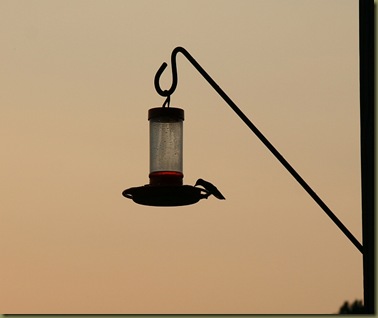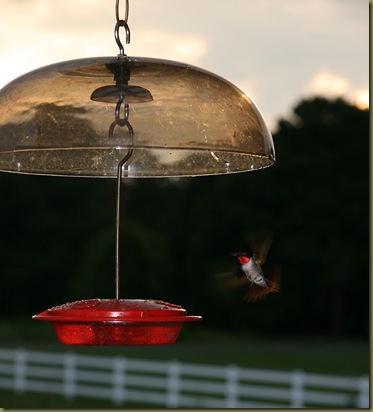With a variety of flowers and a couple nectar feeders on display, I've had the privilege of having lots of ruby-throated humming birds visit in my yard this summer. They are a real joy to watch. They are usually the first birds that I see in the morning and the last ones that I see before dark. I'm guessing this has to do a lot with there high energy and super-fast metabolism that requires them to be almost constantly on the move. Hummingbirds in flight have the highest metabolism of all animals (with the exception of insects), a necessity in order to support the rapid beating of their wings. Their heart rate can reach as high as 1,000+ beats per minute. They typically consume more than their own weight in nectar each day, and to do so they must visit several hundred flowers daily. At night, hummingbirds are capable of slowing down their metabolism. They enter a hibernation-like state known as torpor. During torpor, the heart rate and breathing are slowed dramatically, reducing their need for food.
I once believed the old thought that you must remove your humming bird feeder(s) before the fall of the year so the hummingbirds would migrate on time. Now I know that is not the case. Actually, the opposite is true - they will often fatten up in order to survive the long journey, and thus appreciate your feeder up until they leave. Hummingbirds migrate in response to hormonal changes triggered by the decreasing day length; nothing you can do will make them stay too long, so it's not necessary to stop feeding. So, enjoy them as long as you can!
One of the hummingbirds favorite plants in my landscape this year is the 'Alabama Crimson Honeysuckle'. It's an easy to grow (zones 4 - 7) flowering vine that blooms most of the summer here in SE Virginia.
One of my favorite sites for reading / learning about hummingbirds is hummingbirds.net.


2 comments:
Yes, hummingbirds do sleep. They do so at night by entering into a state known as torpor, which is a state similar to hibernation. Hummingbirds must enter this state to ensure that the birds won't actually starve to death before down. Torpor is a type of deep sleep where an animal lowers its hart and metabolic rate. In a state of torpor the hummingbird lowers its metabolic rate by as much as 95%. A torpid hummingbird consumes up to 50 times less energy than when awake. The lowered metabolic rate also causes a cooled body temperature. A hummingbird's night time body temperature is maintained at a level which is barely sufficient to maintain life. This level is known as their set point and it is far below the normal daytime body temperature of 104°F or 40°C known for other birds of similar size.
There are many reasons why the hummingbird must enter into a state of torpor. Hummingbirds are among the smallest of all warm-blooded animals, and they also lack the insulating downy feathers that are typical for many other bird species. Due to their small body size and lack of insulation, hummingbirds rapidly lose body heat to their surroundings. Even sleeping hummingbirds have huge metabolic demands that must be met in order for them to simply survive the night when they cannot forage. By entering into a state of torpor, a hummingbird is able to save enough energy to survive cold nights by lowering their internal thermostat.
It takes approximately 20 minutes for a hummingbird to awaken from a state of torpor. When awakening, the hummingbird's heart and breathing rates increase and they vibrate their wing muscles. The bird's blood supply will be warmed by heat being generated by their vibrating muscles or from shivering. Shivering helps to warm the hummingbird's body temperature by several degrees each minute and the bird awakens with enough energy reserves to see him through to his first feeding of the morning. Hummingbirds reliably awaken from torpor one or two hours before dawn without any known cues from the environment. It appears that the bird's internal circadian clock is responsible for signaling when it is time to awaken from the state of torpor.
Also, here is a link to a blog post I recently wrote about the metabolism of the hummingbird. Hope you like what you find there.
http://hummingbirdsformom.com/hummingbirds/the-amazing-metoblism-of-the-hummingbird/trackback/
I have been learning about and developing articles on the subject of hummingbirds for athe past year or or so. I opperate two websites on the subject of hummingbirds. If you would like much more information about hummingbirds, please click the links below. The sites contain many articles about hummingbirds, video clips about hummingbirds, an informative tips booklet on hummingbirds, and much more.
Click Here To Visit About Hummingbirds
Hummingbirds For Mom
Zoe, thanks for the additional detailed information! Sounds like you really know your stuff when it comes to hummingbirds. I will definitely check out your web sites. Thanks for stopping by!
Alan
Post a Comment